Organizational Theory and Practice Analysis: Tesco Report
VerifiedAdded on 2022/12/28
|11
|3705
|223
Report
AI Summary
This report provides an in-depth analysis of Tesco's organizational theory and practice. It examines the management style employed by Tesco's CEO, Ken Murphy, and outlines the principles and functions of management utilized within the company. The report further analyzes the organizational structure implemented to achieve high performance, assessing its flexibility and its impact on employees. It explores the leadership style of the CEO, specifically the coaching style, and its influence on enhancing the effectiveness of the company. The effects of power, influence, and conflict within the organization are discussed, along with the various types of motivation used to encourage employees, including Maslow's Hierarchy of Needs. The report utilizes corporate examples and relevant literature to support its findings, offering insights into Tesco's strategies for maintaining its position as a leading retailer. The analysis covers areas such as planning, staffing, controlling, organizing, and directing to understand how Tesco manages its operations and adapts to market changes. The report also addresses the importance of ethical practices, especially in a multinational context, and highlights the significance of employee training and development in fostering a high-performance culture. The impact of organizational culture and conflict management on employee productivity and team dynamics is also evaluated.
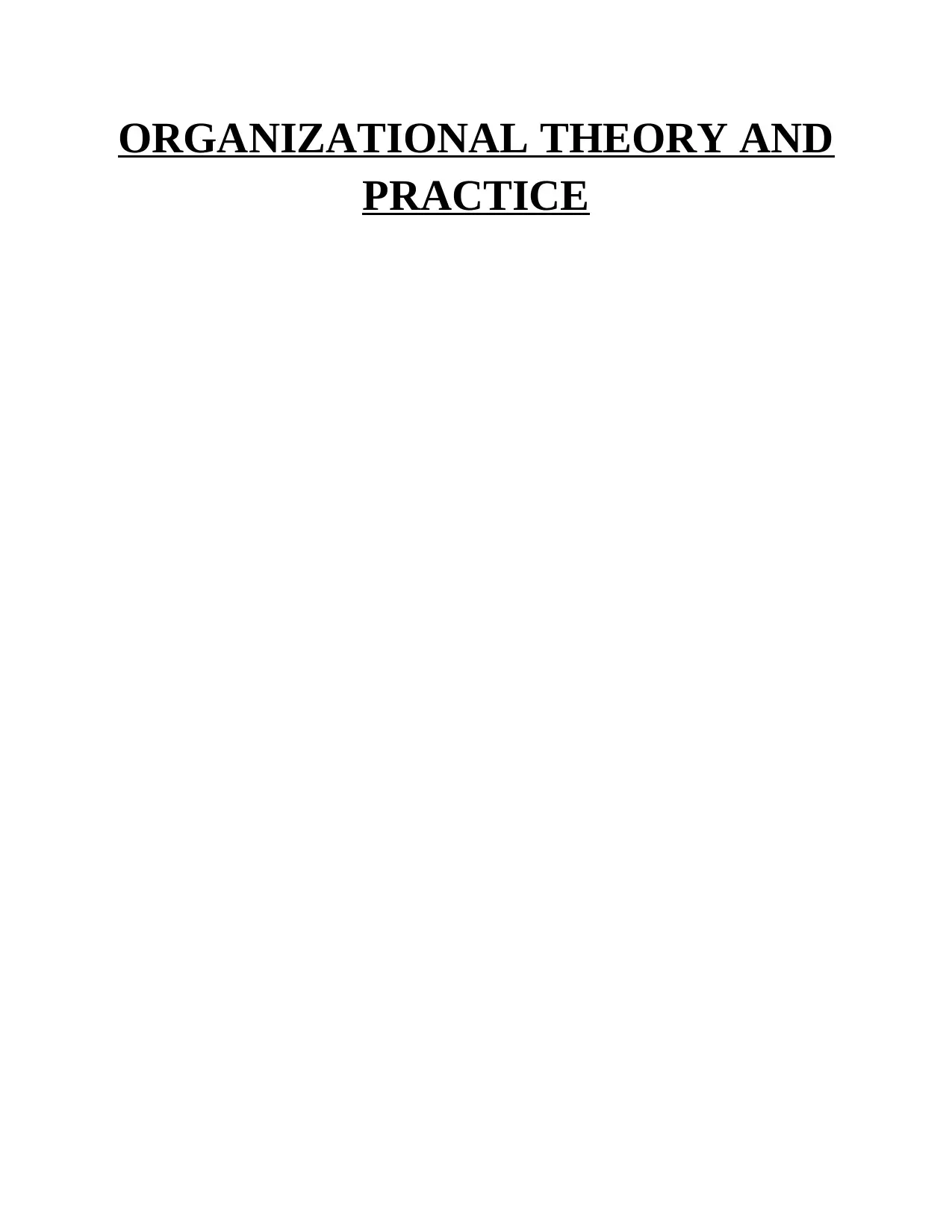
ORGANIZATIONAL THEORY AND
PRACTICE
PRACTICE
Paraphrase This Document
Need a fresh take? Get an instant paraphrase of this document with our AI Paraphraser
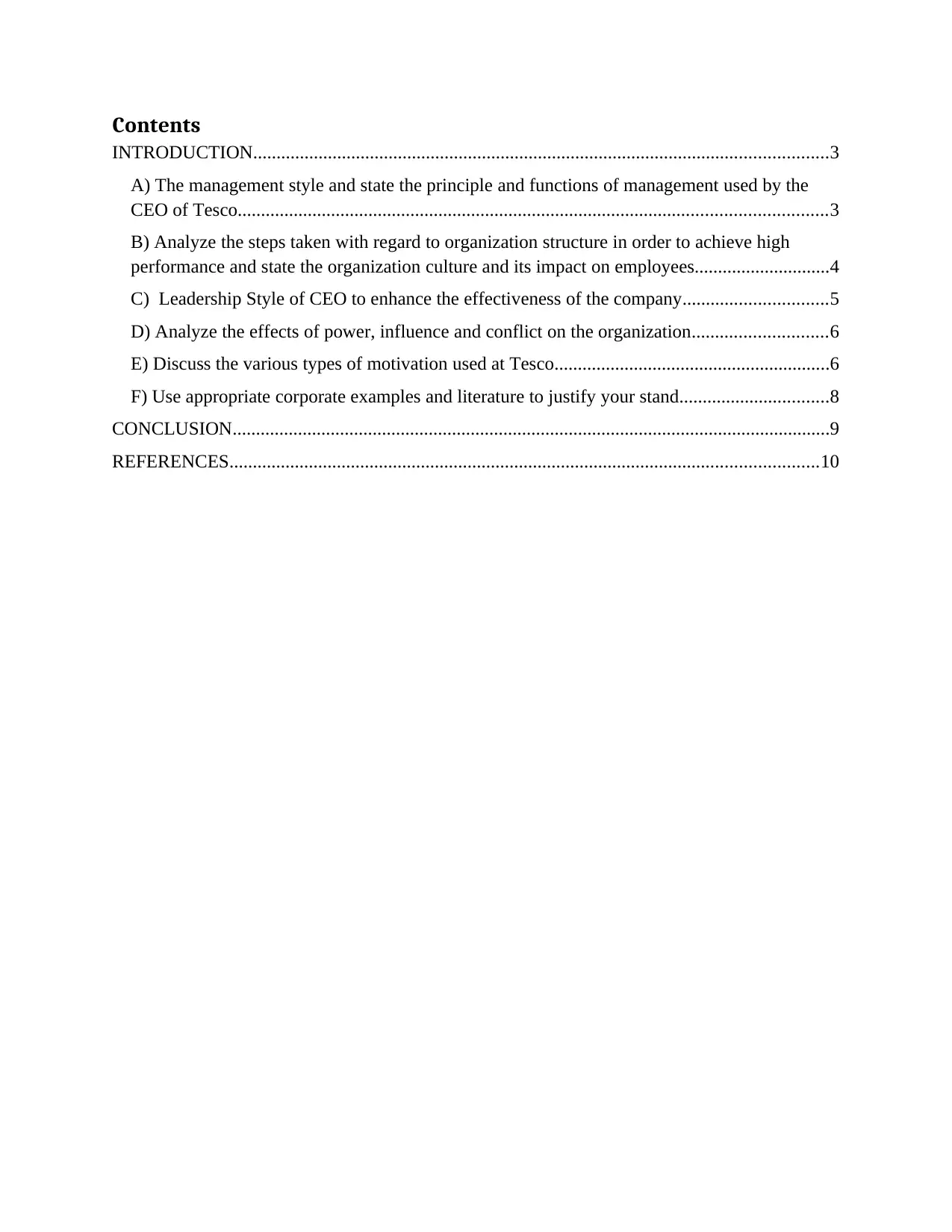
Contents
INTRODUCTION...........................................................................................................................3
A) The management style and state the principle and functions of management used by the
CEO of Tesco..............................................................................................................................3
B) Analyze the steps taken with regard to organization structure in order to achieve high
performance and state the organization culture and its impact on employees.............................4
C) Leadership Style of CEO to enhance the effectiveness of the company...............................5
D) Analyze the effects of power, influence and conflict on the organization.............................6
E) Discuss the various types of motivation used at Tesco...........................................................6
F) Use appropriate corporate examples and literature to justify your stand................................8
CONCLUSION................................................................................................................................9
REFERENCES..............................................................................................................................10
INTRODUCTION...........................................................................................................................3
A) The management style and state the principle and functions of management used by the
CEO of Tesco..............................................................................................................................3
B) Analyze the steps taken with regard to organization structure in order to achieve high
performance and state the organization culture and its impact on employees.............................4
C) Leadership Style of CEO to enhance the effectiveness of the company...............................5
D) Analyze the effects of power, influence and conflict on the organization.............................6
E) Discuss the various types of motivation used at Tesco...........................................................6
F) Use appropriate corporate examples and literature to justify your stand................................8
CONCLUSION................................................................................................................................9
REFERENCES..............................................................................................................................10
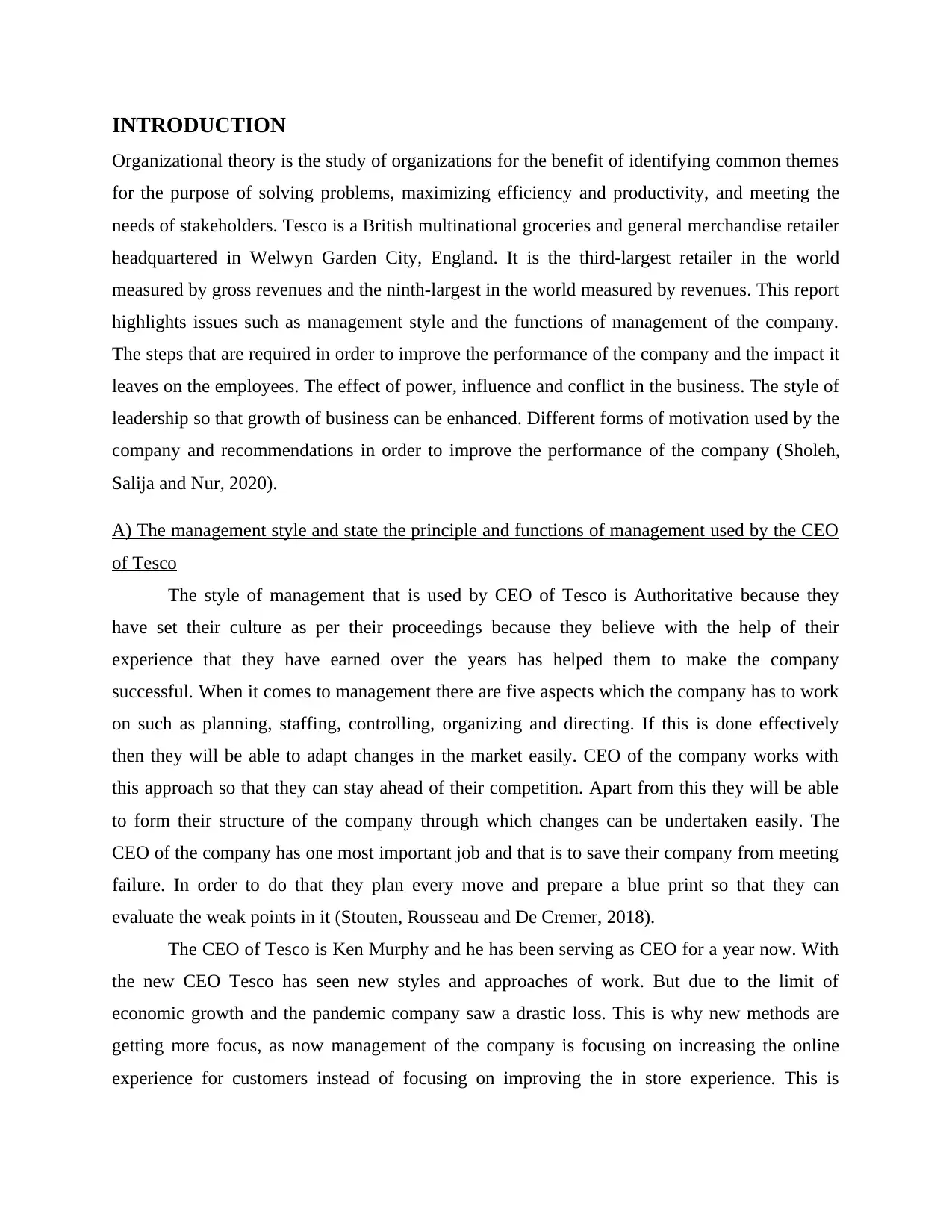
INTRODUCTION
Organizational theory is the study of organizations for the benefit of identifying common themes
for the purpose of solving problems, maximizing efficiency and productivity, and meeting the
needs of stakeholders. Tesco is a British multinational groceries and general merchandise retailer
headquartered in Welwyn Garden City, England. It is the third-largest retailer in the world
measured by gross revenues and the ninth-largest in the world measured by revenues. This report
highlights issues such as management style and the functions of management of the company.
The steps that are required in order to improve the performance of the company and the impact it
leaves on the employees. The effect of power, influence and conflict in the business. The style of
leadership so that growth of business can be enhanced. Different forms of motivation used by the
company and recommendations in order to improve the performance of the company (Sholeh,
Salija and Nur, 2020).
A) The management style and state the principle and functions of management used by the CEO
of Tesco
The style of management that is used by CEO of Tesco is Authoritative because they
have set their culture as per their proceedings because they believe with the help of their
experience that they have earned over the years has helped them to make the company
successful. When it comes to management there are five aspects which the company has to work
on such as planning, staffing, controlling, organizing and directing. If this is done effectively
then they will be able to adapt changes in the market easily. CEO of the company works with
this approach so that they can stay ahead of their competition. Apart from this they will be able
to form their structure of the company through which changes can be undertaken easily. The
CEO of the company has one most important job and that is to save their company from meeting
failure. In order to do that they plan every move and prepare a blue print so that they can
evaluate the weak points in it (Stouten, Rousseau and De Cremer, 2018).
The CEO of Tesco is Ken Murphy and he has been serving as CEO for a year now. With
the new CEO Tesco has seen new styles and approaches of work. But due to the limit of
economic growth and the pandemic company saw a drastic loss. This is why new methods are
getting more focus, as now management of the company is focusing on increasing the online
experience for customers instead of focusing on improving the in store experience. This is
Organizational theory is the study of organizations for the benefit of identifying common themes
for the purpose of solving problems, maximizing efficiency and productivity, and meeting the
needs of stakeholders. Tesco is a British multinational groceries and general merchandise retailer
headquartered in Welwyn Garden City, England. It is the third-largest retailer in the world
measured by gross revenues and the ninth-largest in the world measured by revenues. This report
highlights issues such as management style and the functions of management of the company.
The steps that are required in order to improve the performance of the company and the impact it
leaves on the employees. The effect of power, influence and conflict in the business. The style of
leadership so that growth of business can be enhanced. Different forms of motivation used by the
company and recommendations in order to improve the performance of the company (Sholeh,
Salija and Nur, 2020).
A) The management style and state the principle and functions of management used by the CEO
of Tesco
The style of management that is used by CEO of Tesco is Authoritative because they
have set their culture as per their proceedings because they believe with the help of their
experience that they have earned over the years has helped them to make the company
successful. When it comes to management there are five aspects which the company has to work
on such as planning, staffing, controlling, organizing and directing. If this is done effectively
then they will be able to adapt changes in the market easily. CEO of the company works with
this approach so that they can stay ahead of their competition. Apart from this they will be able
to form their structure of the company through which changes can be undertaken easily. The
CEO of the company has one most important job and that is to save their company from meeting
failure. In order to do that they plan every move and prepare a blue print so that they can
evaluate the weak points in it (Stouten, Rousseau and De Cremer, 2018).
The CEO of Tesco is Ken Murphy and he has been serving as CEO for a year now. With
the new CEO Tesco has seen new styles and approaches of work. But due to the limit of
economic growth and the pandemic company saw a drastic loss. This is why new methods are
getting more focus, as now management of the company is focusing on increasing the online
experience for customers instead of focusing on improving the in store experience. This is
⊘ This is a preview!⊘
Do you want full access?
Subscribe today to unlock all pages.

Trusted by 1+ million students worldwide
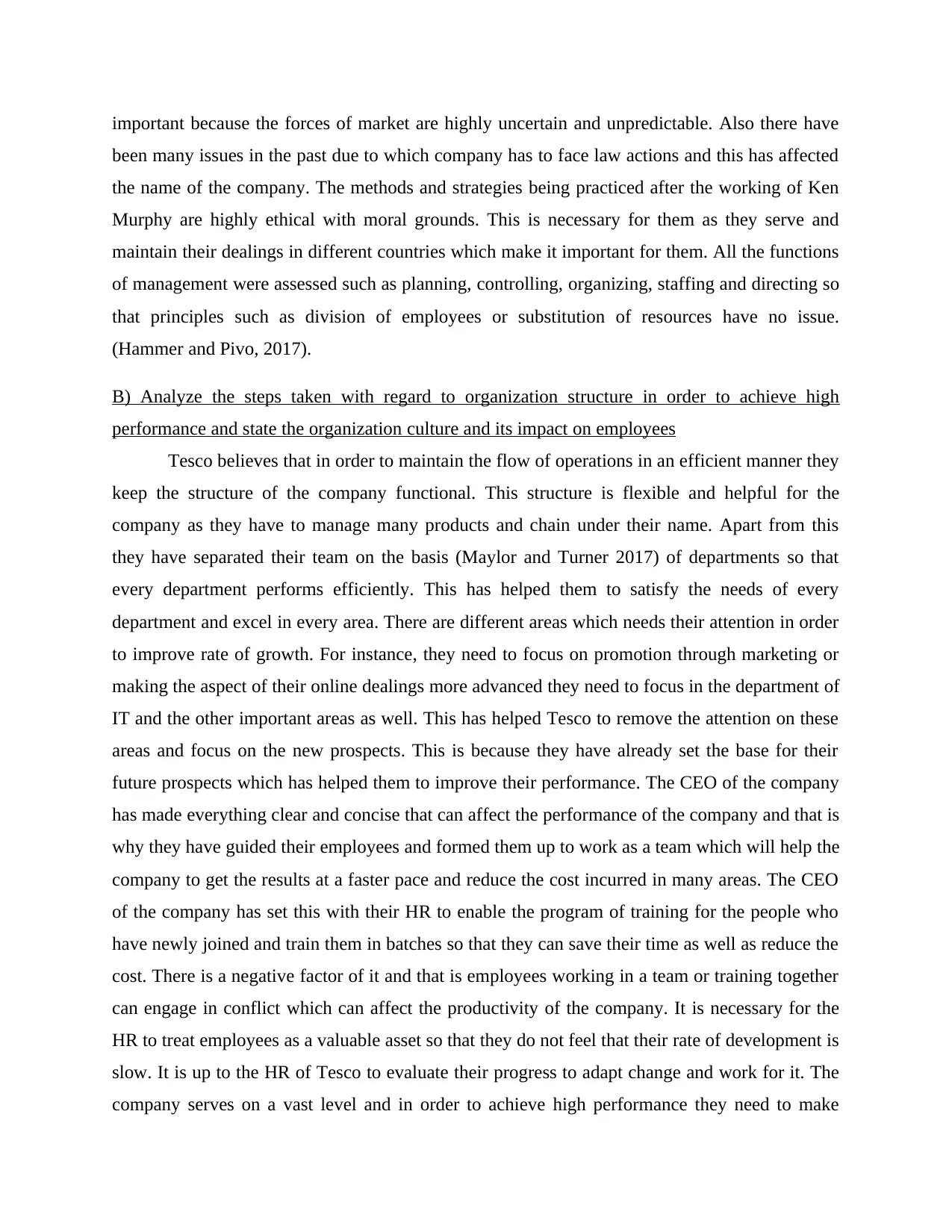
important because the forces of market are highly uncertain and unpredictable. Also there have
been many issues in the past due to which company has to face law actions and this has affected
the name of the company. The methods and strategies being practiced after the working of Ken
Murphy are highly ethical with moral grounds. This is necessary for them as they serve and
maintain their dealings in different countries which make it important for them. All the functions
of management were assessed such as planning, controlling, organizing, staffing and directing so
that principles such as division of employees or substitution of resources have no issue.
(Hammer and Pivo, 2017).
B) Analyze the steps taken with regard to organization structure in order to achieve high
performance and state the organization culture and its impact on employees
Tesco believes that in order to maintain the flow of operations in an efficient manner they
keep the structure of the company functional. This structure is flexible and helpful for the
company as they have to manage many products and chain under their name. Apart from this
they have separated their team on the basis (Maylor and Turner 2017) of departments so that
every department performs efficiently. This has helped them to satisfy the needs of every
department and excel in every area. There are different areas which needs their attention in order
to improve rate of growth. For instance, they need to focus on promotion through marketing or
making the aspect of their online dealings more advanced they need to focus in the department of
IT and the other important areas as well. This has helped Tesco to remove the attention on these
areas and focus on the new prospects. This is because they have already set the base for their
future prospects which has helped them to improve their performance. The CEO of the company
has made everything clear and concise that can affect the performance of the company and that is
why they have guided their employees and formed them up to work as a team which will help the
company to get the results at a faster pace and reduce the cost incurred in many areas. The CEO
of the company has set this with their HR to enable the program of training for the people who
have newly joined and train them in batches so that they can save their time as well as reduce the
cost. There is a negative factor of it and that is employees working in a team or training together
can engage in conflict which can affect the productivity of the company. It is necessary for the
HR to treat employees as a valuable asset so that they do not feel that their rate of development is
slow. It is up to the HR of Tesco to evaluate their progress to adapt change and work for it. The
company serves on a vast level and in order to achieve high performance they need to make
been many issues in the past due to which company has to face law actions and this has affected
the name of the company. The methods and strategies being practiced after the working of Ken
Murphy are highly ethical with moral grounds. This is necessary for them as they serve and
maintain their dealings in different countries which make it important for them. All the functions
of management were assessed such as planning, controlling, organizing, staffing and directing so
that principles such as division of employees or substitution of resources have no issue.
(Hammer and Pivo, 2017).
B) Analyze the steps taken with regard to organization structure in order to achieve high
performance and state the organization culture and its impact on employees
Tesco believes that in order to maintain the flow of operations in an efficient manner they
keep the structure of the company functional. This structure is flexible and helpful for the
company as they have to manage many products and chain under their name. Apart from this
they have separated their team on the basis (Maylor and Turner 2017) of departments so that
every department performs efficiently. This has helped them to satisfy the needs of every
department and excel in every area. There are different areas which needs their attention in order
to improve rate of growth. For instance, they need to focus on promotion through marketing or
making the aspect of their online dealings more advanced they need to focus in the department of
IT and the other important areas as well. This has helped Tesco to remove the attention on these
areas and focus on the new prospects. This is because they have already set the base for their
future prospects which has helped them to improve their performance. The CEO of the company
has made everything clear and concise that can affect the performance of the company and that is
why they have guided their employees and formed them up to work as a team which will help the
company to get the results at a faster pace and reduce the cost incurred in many areas. The CEO
of the company has set this with their HR to enable the program of training for the people who
have newly joined and train them in batches so that they can save their time as well as reduce the
cost. There is a negative factor of it and that is employees working in a team or training together
can engage in conflict which can affect the productivity of the company. It is necessary for the
HR to treat employees as a valuable asset so that they do not feel that their rate of development is
slow. It is up to the HR of Tesco to evaluate their progress to adapt change and work for it. The
company serves on a vast level and in order to achieve high performance they need to make
Paraphrase This Document
Need a fresh take? Get an instant paraphrase of this document with our AI Paraphraser
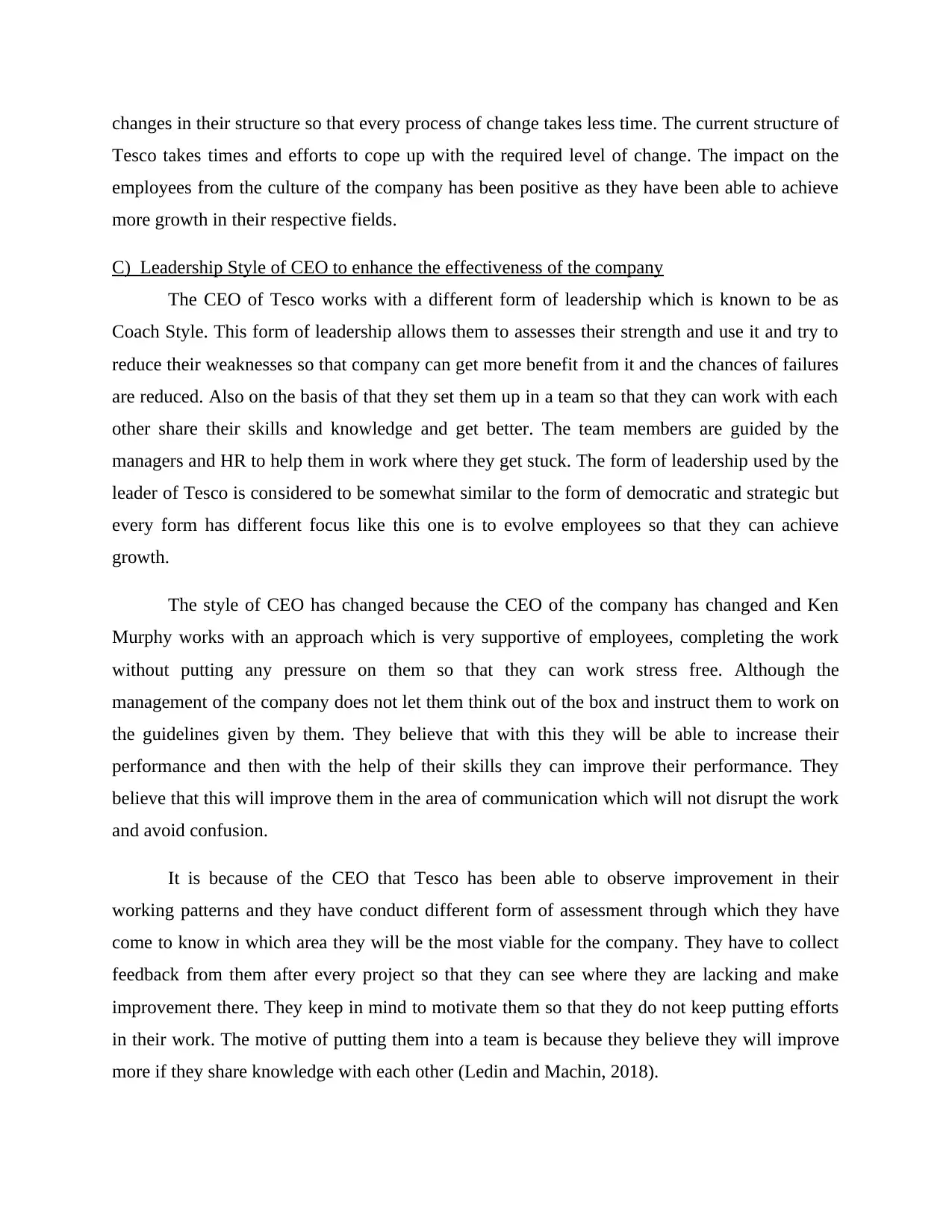
changes in their structure so that every process of change takes less time. The current structure of
Tesco takes times and efforts to cope up with the required level of change. The impact on the
employees from the culture of the company has been positive as they have been able to achieve
more growth in their respective fields.
C) Leadership Style of CEO to enhance the effectiveness of the company
The CEO of Tesco works with a different form of leadership which is known to be as
Coach Style. This form of leadership allows them to assesses their strength and use it and try to
reduce their weaknesses so that company can get more benefit from it and the chances of failures
are reduced. Also on the basis of that they set them up in a team so that they can work with each
other share their skills and knowledge and get better. The team members are guided by the
managers and HR to help them in work where they get stuck. The form of leadership used by the
leader of Tesco is considered to be somewhat similar to the form of democratic and strategic but
every form has different focus like this one is to evolve employees so that they can achieve
growth.
The style of CEO has changed because the CEO of the company has changed and Ken
Murphy works with an approach which is very supportive of employees, completing the work
without putting any pressure on them so that they can work stress free. Although the
management of the company does not let them think out of the box and instruct them to work on
the guidelines given by them. They believe that with this they will be able to increase their
performance and then with the help of their skills they can improve their performance. They
believe that this will improve them in the area of communication which will not disrupt the work
and avoid confusion.
It is because of the CEO that Tesco has been able to observe improvement in their
working patterns and they have conduct different form of assessment through which they have
come to know in which area they will be the most viable for the company. They have to collect
feedback from them after every project so that they can see where they are lacking and make
improvement there. They keep in mind to motivate them so that they do not keep putting efforts
in their work. The motive of putting them into a team is because they believe they will improve
more if they share knowledge with each other (Ledin and Machin, 2018).
Tesco takes times and efforts to cope up with the required level of change. The impact on the
employees from the culture of the company has been positive as they have been able to achieve
more growth in their respective fields.
C) Leadership Style of CEO to enhance the effectiveness of the company
The CEO of Tesco works with a different form of leadership which is known to be as
Coach Style. This form of leadership allows them to assesses their strength and use it and try to
reduce their weaknesses so that company can get more benefit from it and the chances of failures
are reduced. Also on the basis of that they set them up in a team so that they can work with each
other share their skills and knowledge and get better. The team members are guided by the
managers and HR to help them in work where they get stuck. The form of leadership used by the
leader of Tesco is considered to be somewhat similar to the form of democratic and strategic but
every form has different focus like this one is to evolve employees so that they can achieve
growth.
The style of CEO has changed because the CEO of the company has changed and Ken
Murphy works with an approach which is very supportive of employees, completing the work
without putting any pressure on them so that they can work stress free. Although the
management of the company does not let them think out of the box and instruct them to work on
the guidelines given by them. They believe that with this they will be able to increase their
performance and then with the help of their skills they can improve their performance. They
believe that this will improve them in the area of communication which will not disrupt the work
and avoid confusion.
It is because of the CEO that Tesco has been able to observe improvement in their
working patterns and they have conduct different form of assessment through which they have
come to know in which area they will be the most viable for the company. They have to collect
feedback from them after every project so that they can see where they are lacking and make
improvement there. They keep in mind to motivate them so that they do not keep putting efforts
in their work. The motive of putting them into a team is because they believe they will improve
more if they share knowledge with each other (Ledin and Machin, 2018).
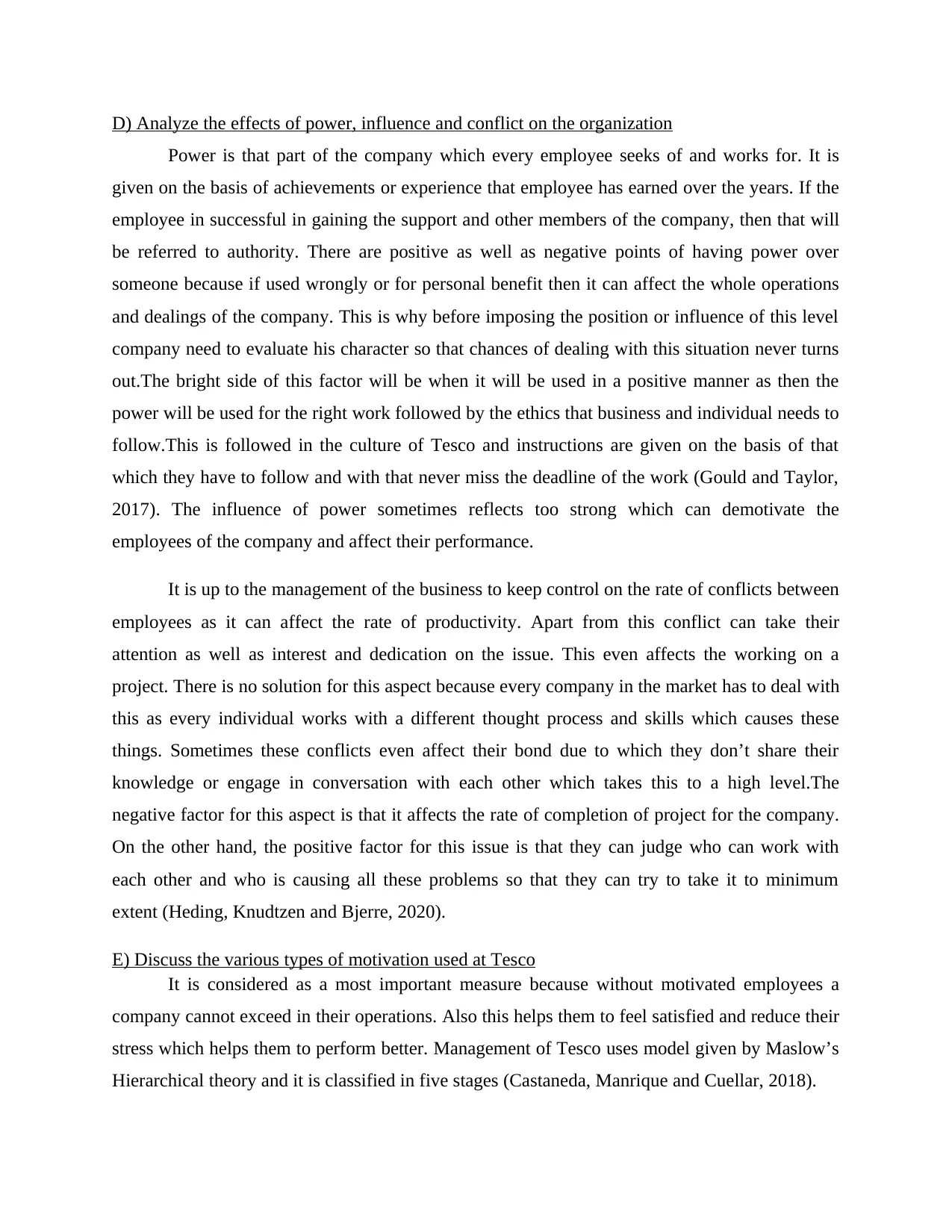
D) Analyze the effects of power, influence and conflict on the organization
Power is that part of the company which every employee seeks of and works for. It is
given on the basis of achievements or experience that employee has earned over the years. If the
employee in successful in gaining the support and other members of the company, then that will
be referred to authority. There are positive as well as negative points of having power over
someone because if used wrongly or for personal benefit then it can affect the whole operations
and dealings of the company. This is why before imposing the position or influence of this level
company need to evaluate his character so that chances of dealing with this situation never turns
out.The bright side of this factor will be when it will be used in a positive manner as then the
power will be used for the right work followed by the ethics that business and individual needs to
follow.This is followed in the culture of Tesco and instructions are given on the basis of that
which they have to follow and with that never miss the deadline of the work (Gould and Taylor,
2017). The influence of power sometimes reflects too strong which can demotivate the
employees of the company and affect their performance.
It is up to the management of the business to keep control on the rate of conflicts between
employees as it can affect the rate of productivity. Apart from this conflict can take their
attention as well as interest and dedication on the issue. This even affects the working on a
project. There is no solution for this aspect because every company in the market has to deal with
this as every individual works with a different thought process and skills which causes these
things. Sometimes these conflicts even affect their bond due to which they don’t share their
knowledge or engage in conversation with each other which takes this to a high level.The
negative factor for this aspect is that it affects the rate of completion of project for the company.
On the other hand, the positive factor for this issue is that they can judge who can work with
each other and who is causing all these problems so that they can try to take it to minimum
extent (Heding, Knudtzen and Bjerre, 2020).
E) Discuss the various types of motivation used at Tesco
It is considered as a most important measure because without motivated employees a
company cannot exceed in their operations. Also this helps them to feel satisfied and reduce their
stress which helps them to perform better. Management of Tesco uses model given by Maslow’s
Hierarchical theory and it is classified in five stages (Castaneda, Manrique and Cuellar, 2018).
Power is that part of the company which every employee seeks of and works for. It is
given on the basis of achievements or experience that employee has earned over the years. If the
employee in successful in gaining the support and other members of the company, then that will
be referred to authority. There are positive as well as negative points of having power over
someone because if used wrongly or for personal benefit then it can affect the whole operations
and dealings of the company. This is why before imposing the position or influence of this level
company need to evaluate his character so that chances of dealing with this situation never turns
out.The bright side of this factor will be when it will be used in a positive manner as then the
power will be used for the right work followed by the ethics that business and individual needs to
follow.This is followed in the culture of Tesco and instructions are given on the basis of that
which they have to follow and with that never miss the deadline of the work (Gould and Taylor,
2017). The influence of power sometimes reflects too strong which can demotivate the
employees of the company and affect their performance.
It is up to the management of the business to keep control on the rate of conflicts between
employees as it can affect the rate of productivity. Apart from this conflict can take their
attention as well as interest and dedication on the issue. This even affects the working on a
project. There is no solution for this aspect because every company in the market has to deal with
this as every individual works with a different thought process and skills which causes these
things. Sometimes these conflicts even affect their bond due to which they don’t share their
knowledge or engage in conversation with each other which takes this to a high level.The
negative factor for this aspect is that it affects the rate of completion of project for the company.
On the other hand, the positive factor for this issue is that they can judge who can work with
each other and who is causing all these problems so that they can try to take it to minimum
extent (Heding, Knudtzen and Bjerre, 2020).
E) Discuss the various types of motivation used at Tesco
It is considered as a most important measure because without motivated employees a
company cannot exceed in their operations. Also this helps them to feel satisfied and reduce their
stress which helps them to perform better. Management of Tesco uses model given by Maslow’s
Hierarchical theory and it is classified in five stages (Castaneda, Manrique and Cuellar, 2018).
⊘ This is a preview!⊘
Do you want full access?
Subscribe today to unlock all pages.

Trusted by 1+ million students worldwide
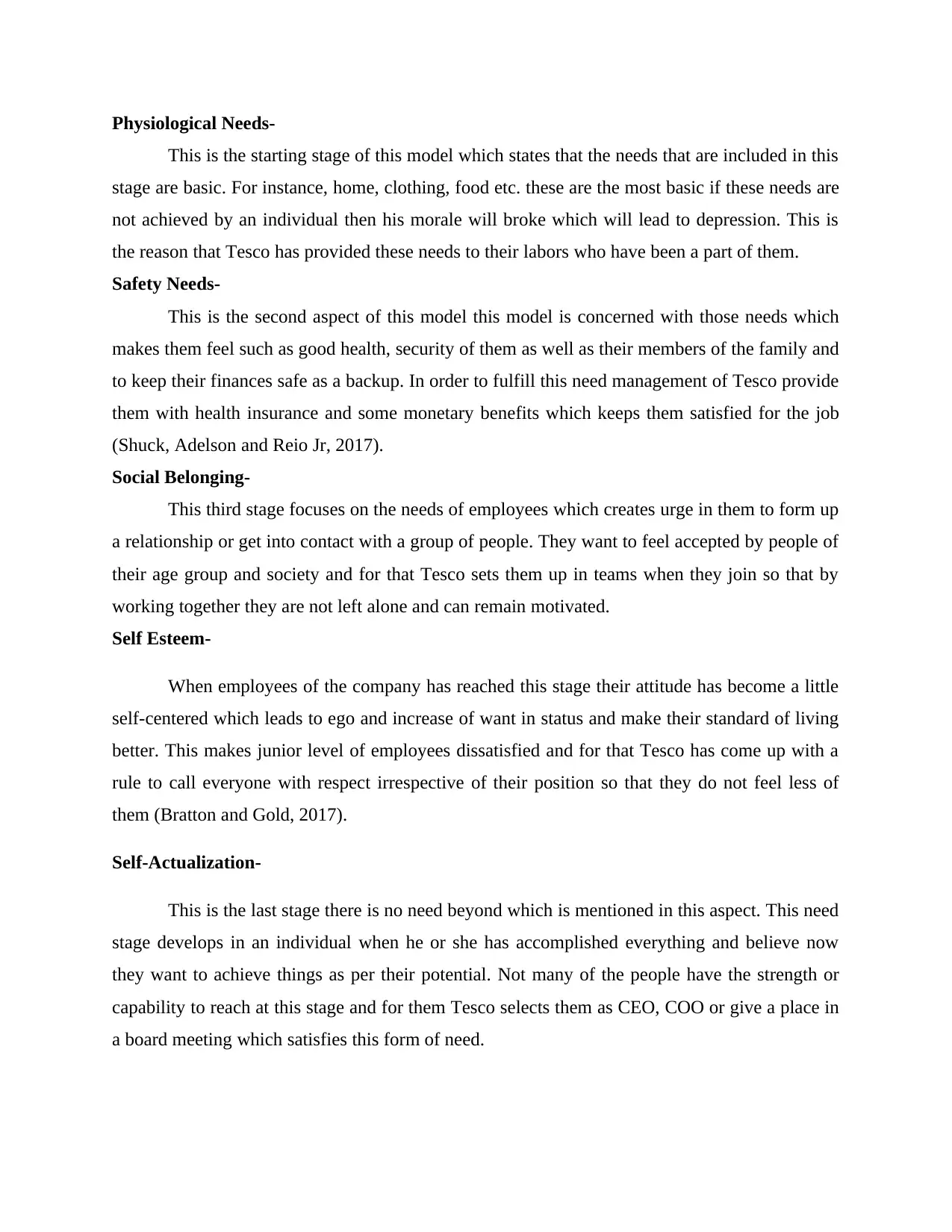
Physiological Needs-
This is the starting stage of this model which states that the needs that are included in this
stage are basic. For instance, home, clothing, food etc. these are the most basic if these needs are
not achieved by an individual then his morale will broke which will lead to depression. This is
the reason that Tesco has provided these needs to their labors who have been a part of them.
Safety Needs-
This is the second aspect of this model this model is concerned with those needs which
makes them feel such as good health, security of them as well as their members of the family and
to keep their finances safe as a backup. In order to fulfill this need management of Tesco provide
them with health insurance and some monetary benefits which keeps them satisfied for the job
(Shuck, Adelson and Reio Jr, 2017).
Social Belonging-
This third stage focuses on the needs of employees which creates urge in them to form up
a relationship or get into contact with a group of people. They want to feel accepted by people of
their age group and society and for that Tesco sets them up in teams when they join so that by
working together they are not left alone and can remain motivated.
Self Esteem-
When employees of the company has reached this stage their attitude has become a little
self-centered which leads to ego and increase of want in status and make their standard of living
better. This makes junior level of employees dissatisfied and for that Tesco has come up with a
rule to call everyone with respect irrespective of their position so that they do not feel less of
them (Bratton and Gold, 2017).
Self-Actualization-
This is the last stage there is no need beyond which is mentioned in this aspect. This need
stage develops in an individual when he or she has accomplished everything and believe now
they want to achieve things as per their potential. Not many of the people have the strength or
capability to reach at this stage and for them Tesco selects them as CEO, COO or give a place in
a board meeting which satisfies this form of need.
This is the starting stage of this model which states that the needs that are included in this
stage are basic. For instance, home, clothing, food etc. these are the most basic if these needs are
not achieved by an individual then his morale will broke which will lead to depression. This is
the reason that Tesco has provided these needs to their labors who have been a part of them.
Safety Needs-
This is the second aspect of this model this model is concerned with those needs which
makes them feel such as good health, security of them as well as their members of the family and
to keep their finances safe as a backup. In order to fulfill this need management of Tesco provide
them with health insurance and some monetary benefits which keeps them satisfied for the job
(Shuck, Adelson and Reio Jr, 2017).
Social Belonging-
This third stage focuses on the needs of employees which creates urge in them to form up
a relationship or get into contact with a group of people. They want to feel accepted by people of
their age group and society and for that Tesco sets them up in teams when they join so that by
working together they are not left alone and can remain motivated.
Self Esteem-
When employees of the company has reached this stage their attitude has become a little
self-centered which leads to ego and increase of want in status and make their standard of living
better. This makes junior level of employees dissatisfied and for that Tesco has come up with a
rule to call everyone with respect irrespective of their position so that they do not feel less of
them (Bratton and Gold, 2017).
Self-Actualization-
This is the last stage there is no need beyond which is mentioned in this aspect. This need
stage develops in an individual when he or she has accomplished everything and believe now
they want to achieve things as per their potential. Not many of the people have the strength or
capability to reach at this stage and for them Tesco selects them as CEO, COO or give a place in
a board meeting which satisfies this form of need.
Paraphrase This Document
Need a fresh take? Get an instant paraphrase of this document with our AI Paraphraser
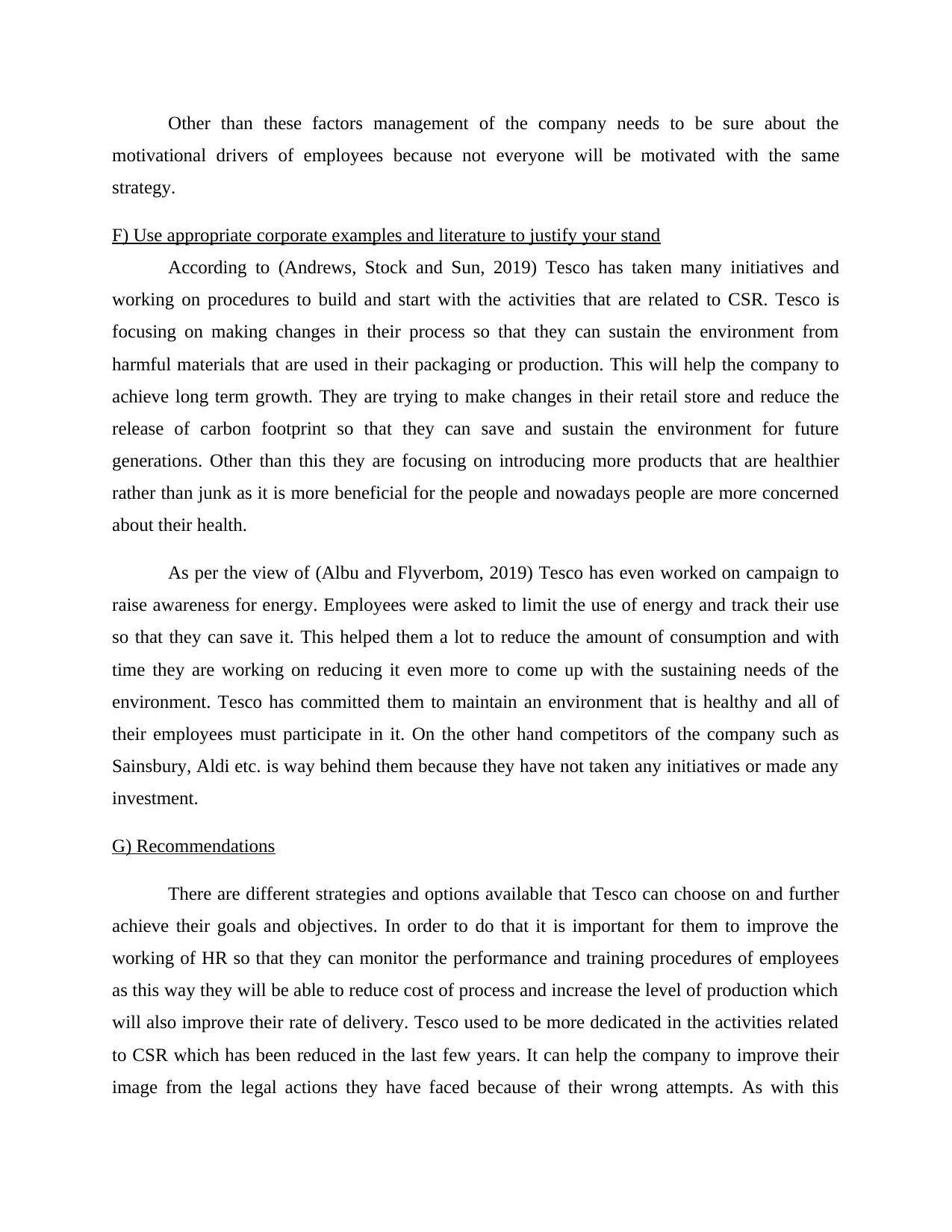
Other than these factors management of the company needs to be sure about the
motivational drivers of employees because not everyone will be motivated with the same
strategy.
F) Use appropriate corporate examples and literature to justify your stand
According to (Andrews, Stock and Sun, 2019) Tesco has taken many initiatives and
working on procedures to build and start with the activities that are related to CSR. Tesco is
focusing on making changes in their process so that they can sustain the environment from
harmful materials that are used in their packaging or production. This will help the company to
achieve long term growth. They are trying to make changes in their retail store and reduce the
release of carbon footprint so that they can save and sustain the environment for future
generations. Other than this they are focusing on introducing more products that are healthier
rather than junk as it is more beneficial for the people and nowadays people are more concerned
about their health.
As per the view of (Albu and Flyverbom, 2019) Tesco has even worked on campaign to
raise awareness for energy. Employees were asked to limit the use of energy and track their use
so that they can save it. This helped them a lot to reduce the amount of consumption and with
time they are working on reducing it even more to come up with the sustaining needs of the
environment. Tesco has committed them to maintain an environment that is healthy and all of
their employees must participate in it. On the other hand competitors of the company such as
Sainsbury, Aldi etc. is way behind them because they have not taken any initiatives or made any
investment.
G) Recommendations
There are different strategies and options available that Tesco can choose on and further
achieve their goals and objectives. In order to do that it is important for them to improve the
working of HR so that they can monitor the performance and training procedures of employees
as this way they will be able to reduce cost of process and increase the level of production which
will also improve their rate of delivery. Tesco used to be more dedicated in the activities related
to CSR which has been reduced in the last few years. It can help the company to improve their
image from the legal actions they have faced because of their wrong attempts. As with this
motivational drivers of employees because not everyone will be motivated with the same
strategy.
F) Use appropriate corporate examples and literature to justify your stand
According to (Andrews, Stock and Sun, 2019) Tesco has taken many initiatives and
working on procedures to build and start with the activities that are related to CSR. Tesco is
focusing on making changes in their process so that they can sustain the environment from
harmful materials that are used in their packaging or production. This will help the company to
achieve long term growth. They are trying to make changes in their retail store and reduce the
release of carbon footprint so that they can save and sustain the environment for future
generations. Other than this they are focusing on introducing more products that are healthier
rather than junk as it is more beneficial for the people and nowadays people are more concerned
about their health.
As per the view of (Albu and Flyverbom, 2019) Tesco has even worked on campaign to
raise awareness for energy. Employees were asked to limit the use of energy and track their use
so that they can save it. This helped them a lot to reduce the amount of consumption and with
time they are working on reducing it even more to come up with the sustaining needs of the
environment. Tesco has committed them to maintain an environment that is healthy and all of
their employees must participate in it. On the other hand competitors of the company such as
Sainsbury, Aldi etc. is way behind them because they have not taken any initiatives or made any
investment.
G) Recommendations
There are different strategies and options available that Tesco can choose on and further
achieve their goals and objectives. In order to do that it is important for them to improve the
working of HR so that they can monitor the performance and training procedures of employees
as this way they will be able to reduce cost of process and increase the level of production which
will also improve their rate of delivery. Tesco used to be more dedicated in the activities related
to CSR which has been reduced in the last few years. It can help the company to improve their
image from the legal actions they have faced because of their wrong attempts. As with this
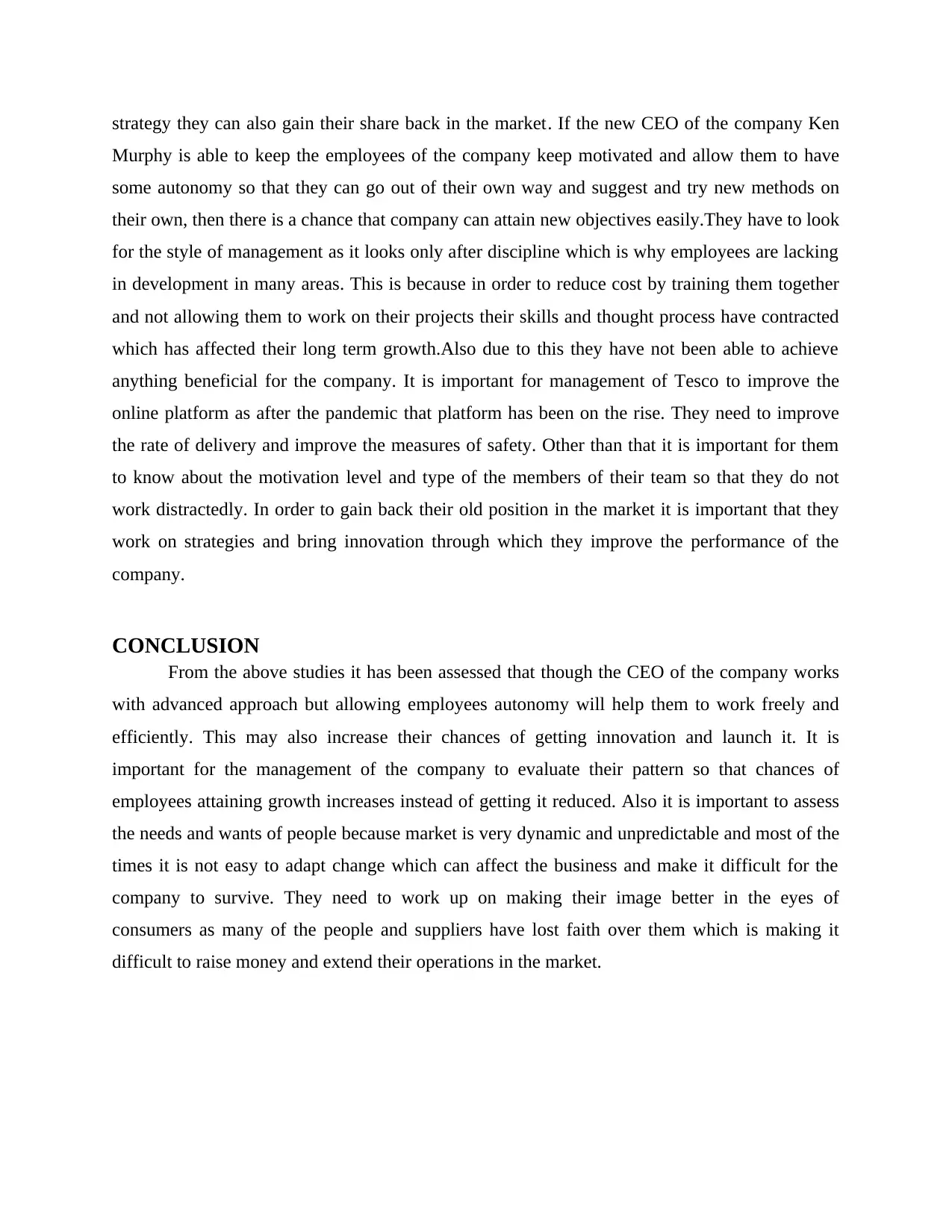
strategy they can also gain their share back in the market. If the new CEO of the company Ken
Murphy is able to keep the employees of the company keep motivated and allow them to have
some autonomy so that they can go out of their own way and suggest and try new methods on
their own, then there is a chance that company can attain new objectives easily.They have to look
for the style of management as it looks only after discipline which is why employees are lacking
in development in many areas. This is because in order to reduce cost by training them together
and not allowing them to work on their projects their skills and thought process have contracted
which has affected their long term growth.Also due to this they have not been able to achieve
anything beneficial for the company. It is important for management of Tesco to improve the
online platform as after the pandemic that platform has been on the rise. They need to improve
the rate of delivery and improve the measures of safety. Other than that it is important for them
to know about the motivation level and type of the members of their team so that they do not
work distractedly. In order to gain back their old position in the market it is important that they
work on strategies and bring innovation through which they improve the performance of the
company.
CONCLUSION
From the above studies it has been assessed that though the CEO of the company works
with advanced approach but allowing employees autonomy will help them to work freely and
efficiently. This may also increase their chances of getting innovation and launch it. It is
important for the management of the company to evaluate their pattern so that chances of
employees attaining growth increases instead of getting it reduced. Also it is important to assess
the needs and wants of people because market is very dynamic and unpredictable and most of the
times it is not easy to adapt change which can affect the business and make it difficult for the
company to survive. They need to work up on making their image better in the eyes of
consumers as many of the people and suppliers have lost faith over them which is making it
difficult to raise money and extend their operations in the market.
Murphy is able to keep the employees of the company keep motivated and allow them to have
some autonomy so that they can go out of their own way and suggest and try new methods on
their own, then there is a chance that company can attain new objectives easily.They have to look
for the style of management as it looks only after discipline which is why employees are lacking
in development in many areas. This is because in order to reduce cost by training them together
and not allowing them to work on their projects their skills and thought process have contracted
which has affected their long term growth.Also due to this they have not been able to achieve
anything beneficial for the company. It is important for management of Tesco to improve the
online platform as after the pandemic that platform has been on the rise. They need to improve
the rate of delivery and improve the measures of safety. Other than that it is important for them
to know about the motivation level and type of the members of their team so that they do not
work distractedly. In order to gain back their old position in the market it is important that they
work on strategies and bring innovation through which they improve the performance of the
company.
CONCLUSION
From the above studies it has been assessed that though the CEO of the company works
with advanced approach but allowing employees autonomy will help them to work freely and
efficiently. This may also increase their chances of getting innovation and launch it. It is
important for the management of the company to evaluate their pattern so that chances of
employees attaining growth increases instead of getting it reduced. Also it is important to assess
the needs and wants of people because market is very dynamic and unpredictable and most of the
times it is not easy to adapt change which can affect the business and make it difficult for the
company to survive. They need to work up on making their image better in the eyes of
consumers as many of the people and suppliers have lost faith over them which is making it
difficult to raise money and extend their operations in the market.
⊘ This is a preview!⊘
Do you want full access?
Subscribe today to unlock all pages.

Trusted by 1+ million students worldwide

Paraphrase This Document
Need a fresh take? Get an instant paraphrase of this document with our AI Paraphraser
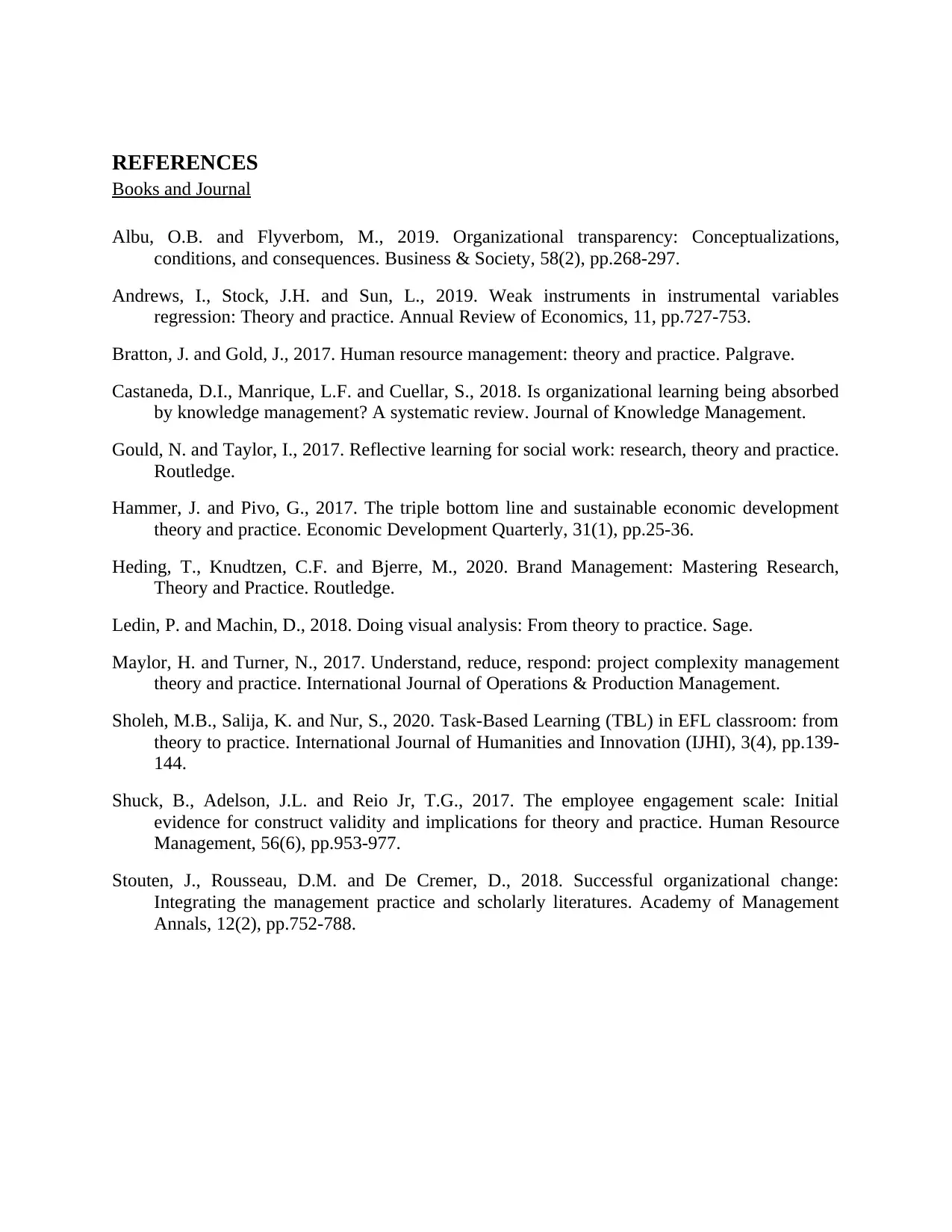
REFERENCES
Books and Journal
Albu, O.B. and Flyverbom, M., 2019. Organizational transparency: Conceptualizations,
conditions, and consequences. Business & Society, 58(2), pp.268-297.
Andrews, I., Stock, J.H. and Sun, L., 2019. Weak instruments in instrumental variables
regression: Theory and practice. Annual Review of Economics, 11, pp.727-753.
Bratton, J. and Gold, J., 2017. Human resource management: theory and practice. Palgrave.
Castaneda, D.I., Manrique, L.F. and Cuellar, S., 2018. Is organizational learning being absorbed
by knowledge management? A systematic review. Journal of Knowledge Management.
Gould, N. and Taylor, I., 2017. Reflective learning for social work: research, theory and practice.
Routledge.
Hammer, J. and Pivo, G., 2017. The triple bottom line and sustainable economic development
theory and practice. Economic Development Quarterly, 31(1), pp.25-36.
Heding, T., Knudtzen, C.F. and Bjerre, M., 2020. Brand Management: Mastering Research,
Theory and Practice. Routledge.
Ledin, P. and Machin, D., 2018. Doing visual analysis: From theory to practice. Sage.
Maylor, H. and Turner, N., 2017. Understand, reduce, respond: project complexity management
theory and practice. International Journal of Operations & Production Management.
Sholeh, M.B., Salija, K. and Nur, S., 2020. Task-Based Learning (TBL) in EFL classroom: from
theory to practice. International Journal of Humanities and Innovation (IJHI), 3(4), pp.139-
144.
Shuck, B., Adelson, J.L. and Reio Jr, T.G., 2017. The employee engagement scale: Initial
evidence for construct validity and implications for theory and practice. Human Resource
Management, 56(6), pp.953-977.
Stouten, J., Rousseau, D.M. and De Cremer, D., 2018. Successful organizational change:
Integrating the management practice and scholarly literatures. Academy of Management
Annals, 12(2), pp.752-788.
Books and Journal
Albu, O.B. and Flyverbom, M., 2019. Organizational transparency: Conceptualizations,
conditions, and consequences. Business & Society, 58(2), pp.268-297.
Andrews, I., Stock, J.H. and Sun, L., 2019. Weak instruments in instrumental variables
regression: Theory and practice. Annual Review of Economics, 11, pp.727-753.
Bratton, J. and Gold, J., 2017. Human resource management: theory and practice. Palgrave.
Castaneda, D.I., Manrique, L.F. and Cuellar, S., 2018. Is organizational learning being absorbed
by knowledge management? A systematic review. Journal of Knowledge Management.
Gould, N. and Taylor, I., 2017. Reflective learning for social work: research, theory and practice.
Routledge.
Hammer, J. and Pivo, G., 2017. The triple bottom line and sustainable economic development
theory and practice. Economic Development Quarterly, 31(1), pp.25-36.
Heding, T., Knudtzen, C.F. and Bjerre, M., 2020. Brand Management: Mastering Research,
Theory and Practice. Routledge.
Ledin, P. and Machin, D., 2018. Doing visual analysis: From theory to practice. Sage.
Maylor, H. and Turner, N., 2017. Understand, reduce, respond: project complexity management
theory and practice. International Journal of Operations & Production Management.
Sholeh, M.B., Salija, K. and Nur, S., 2020. Task-Based Learning (TBL) in EFL classroom: from
theory to practice. International Journal of Humanities and Innovation (IJHI), 3(4), pp.139-
144.
Shuck, B., Adelson, J.L. and Reio Jr, T.G., 2017. The employee engagement scale: Initial
evidence for construct validity and implications for theory and practice. Human Resource
Management, 56(6), pp.953-977.
Stouten, J., Rousseau, D.M. and De Cremer, D., 2018. Successful organizational change:
Integrating the management practice and scholarly literatures. Academy of Management
Annals, 12(2), pp.752-788.
1 out of 11
Related Documents
Your All-in-One AI-Powered Toolkit for Academic Success.
+13062052269
info@desklib.com
Available 24*7 on WhatsApp / Email
![[object Object]](/_next/static/media/star-bottom.7253800d.svg)
Unlock your academic potential
Copyright © 2020–2025 A2Z Services. All Rights Reserved. Developed and managed by ZUCOL.





